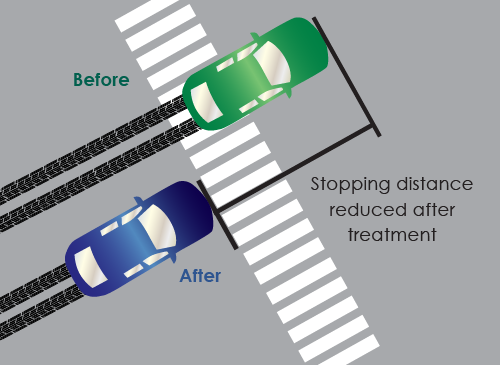High Friction Surface Treatment
High Friction Surface Treatment (HFST) is an innovative technique to improve the safety of motorists at high-priority crash locations throughout the commonwealth. HFST is a Federal Highway Administration (FHWA) Every Day Counts Round 2 (EDC-2) innovation that Pennsylvania championed.
How Does It Work?

Road surfaces become polished in areas where drivers brake often, like going around curves, down steep roads, or at an intersection. This makes vehicles skid more because there is less friction between the tires and the road surface. Wet road surfaces can also reduce pavement friction and cause skidding or hydroplaning.
High Friction Surface treatment is added to the top of a road surface. It uses materials, such as bauxite, to create more friction on pavement. These materials, called aggregates, are high quality and are less likely to wear down than normal pavement. Having greater friction helps to keep vehicles in their lane on slippery pavement around curves and helps the driver to stop.
HFST can be applied by a specialized truck, which distributes the epoxy onto the roadway followed by a spreading of aggregate, or manually, with the epoxy being applied on the roadway and spread with a squeegee, while staff follows closely behind shoveling the aggregate onto the epoxy. While manual application (for smaller jobs) is a cost-effective alternative for local governments wanting to benefit from HFST while trying to keep the expenses low, it is more labor intensive and may result in an uneven displacement of epoxy and binder agent.
What Are The Benefits?
Innovation in Motion
Among the locations where HFST has been applied, follow-up crash analysis at 47 of those locations, where crash data was available for at least three to five years after HFST was applied, showed a significant crash reduction in wet-road, run-off-the-road, hit fixed object, and all crashes. At one location, State Route 611 in Northampton County, the frequency of crashes was reduced by 100 percent. Additionally, fatalities at these locations went from eight to zero and injury crashes went from 190 to 71 a 63 percent decrease. When PennDOT evaluated the cost-benefit ratio of HFST, it found that it saves roughly one life each year for every 15 locations it was applied.
In June 2023, PennDOT, in partnership with Pennsylvania State University, published a report that quantified the safety effects of HFST on horizontal curves and at intersections across the state. The project developed crash modification factors (CMFs) for severe (fatal and injury) crashes, total crashes, and various crash types. The data set included over 57 treated miles, consisting of 700 horizontal curves and 33 intersections, making it one of the largest studies of its kind in the U.S.
For horizontal curves on two-lane rural roads, the PennDOT study findings were consistent with results from other U.S. studies; application of HFST led to a reduction of fatal and injury crashes by 48 percent. This confirmed that HFST is a highly effective strategy for mitigating run-off-road crashes at curves. This study is particularly notable for developing CMFs for applying HFST at intersections, including stop-controlled and signalized in urban and rural contexts. For this scenario, the analysis found a combined reduction of fatal and injury crashes by 76 percent.
More Information
For more information about this innovation, contact the
STIC Management Team.